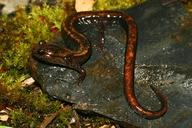|
Plethodon elongatus Van Denburgh, 1916
Del Norte Salamander Subgenus: Hightonia | family: Plethodontidae subfamily: Plethodontinae genus: Plethodon |
 © 2009 William Flaxington (1 of 60) |
|
|
|
Description Distribution and Habitat Country distribution from AmphibiaWeb's database: United States U.S. state distribution from AmphibiaWeb's database: California, Oregon
Life History, Abundance, Activity, and Special Behaviors The diet consists of small invertebrates including isopods, mites, spiders, hemipterans, beetles, hymenopterans, lepidopterans, and centipedes. Predators have not been documented, but probably include small snakes and mammals, and woodland birds (Petranka 1998). When uncovered or attacked individuals of P. elongatus remain immobile (Brodie 1977). Trends and Threats Comments See another account at californiaherps.com.
References
Brodie, E. D., Jr. (1977). "Salamander antipredator postures." Copeia, 1977, 523-535. Brodie, E. D., Jr., and Storm, R. M. (1971). ''Plethodon elongatus Van Denburgh. Del Norte Salamander.'' Catalogue of American Amphibians and Reptiles. Society for the Study of Amphibians and Reptiles, 102.1-102.2. Diller, L. V., and Wallace, R. L. (1994). ''Distribution and habitat of Plethodon elongatus on managed, young growth forests in Northern Coastal California.'' Journal of Herpetology, 28(3), 310-318. Duellman, W. E., and Trueb, L. (1986). Biology of Amphibians. McGraw-Hill, New York. Jockusch, E. L., and Mahoney, M. J. (1997). ''Communal oviposition and lack of parental care in Batrachoseps nigriventris (Caudata: Plethodontidae) with a discussion of the evolution of breeding behavior in plethodontid salamanders.'' Copeia, 1997, 1966-1982. Leonard, W.P., Brown, H.A., Jones, L.L.C., McAllister, K.R., and Storm, R.M. (1993). Amphibians of Washington and Oregon. Seattle Audubon, Seattle. Nussbaum, R. A., Brodie, E. D., Jr., and Storm, R. M. (1983). Amphibians and Reptiles of the Pacific Northwest. University of Idaho Press, Moscow, Idaho. Petranka, J. W. (1998). Salamanders of the United States and Canada. Smithsonian Institution Press, Washington D.C. and London. Stebbins, R. C. (1985). A Field Guide to Western Reptiles and Amphibians. Houghton Mifflin, Boston. Stebbins, R.C. (1951). Amphibians of Western North America. University of California Press, Berkeley. Welsh, H. H., Jr. and Lind, A. J. (1988). ''Old growth forests and the distribution of the terrestrial herpetofauna.'' Management of amphibians, reptiles, and mammals in North America, General Technical Report RM-166. R. C. Szaro, K. E. Severson, and D. R. Patton, eds., USDA Forest Service, Rocky Mountain Forest and Range Experimental Station, Fort Collins, Colorado, 439-455. Welsh, H. H., Jr. and Lind, A. J. (1991). ''The structure of the herpetofaunal assemblage in the Douglas-fir/hardwood forests of northwestern California and southwestern Oregon.'' Wildlife and Vegetation of Unmanaged Douglas-fir Forests, USDA Forest Service, General Technical Report PNW-GTR-285. L. F. Ruggiero, K. B. Aubry, A. B. Carey, and M. H. Huff, eds., USDA Forest Service, 394-413. Welsh, H. H., Jr., and Lind, A. J. (1992). ''Population ecology of two relictual salamanders from the Klamath Mountains of northwestern California.'' Wildlife 2001: Populations. McCullough, D.R., and R.H. Barrett, eds., Elsevier Applied Science, New York., 419-437. Welsh, H.H., Jr., and Lind, A. J. (1995). ''Habitat correlates of the Del Norte Salamander (Plethodon elongatus) (Caudata: Plethodontidae), in northwestern California.'' Journal of Herpetology, 29(2), 198-210. Originally submitted by: Alan Krakauer, Meredith J. Mahoney (first posted 1999-02-19) Edited by: Meredith J. Mahoney (2021-03-18) Species Account Citation: AmphibiaWeb 2021 Plethodon elongatus: Del Norte Salamander <https://amphibiaweb.org/species/4130> University of California, Berkeley, CA, USA. Accessed Jun 14, 2025.
Feedback or comments about this page.
Citation: AmphibiaWeb. 2025. <https://amphibiaweb.org> University of California, Berkeley, CA, USA. Accessed 14 Jun 2025. AmphibiaWeb's policy on data use. |



 Raffaëlli Account
Raffaëlli Account Map of Life
Map of Life